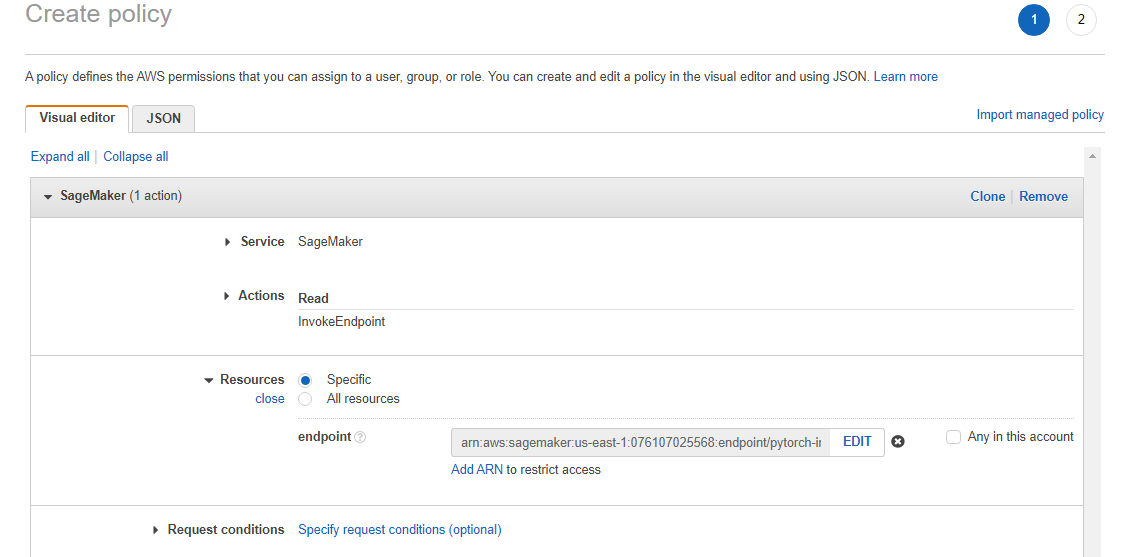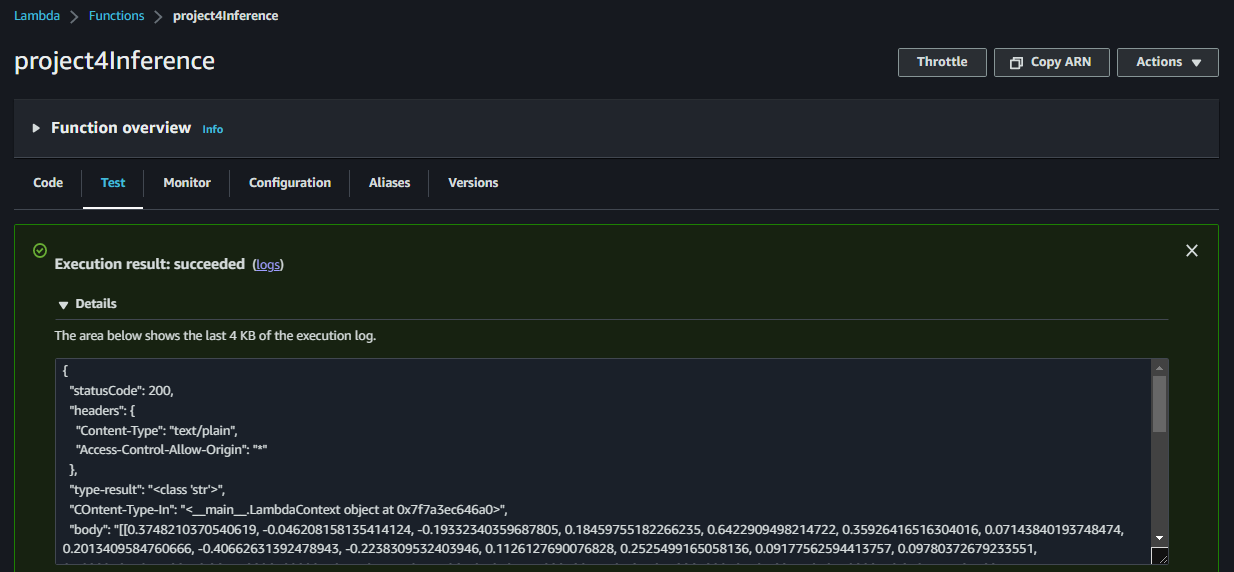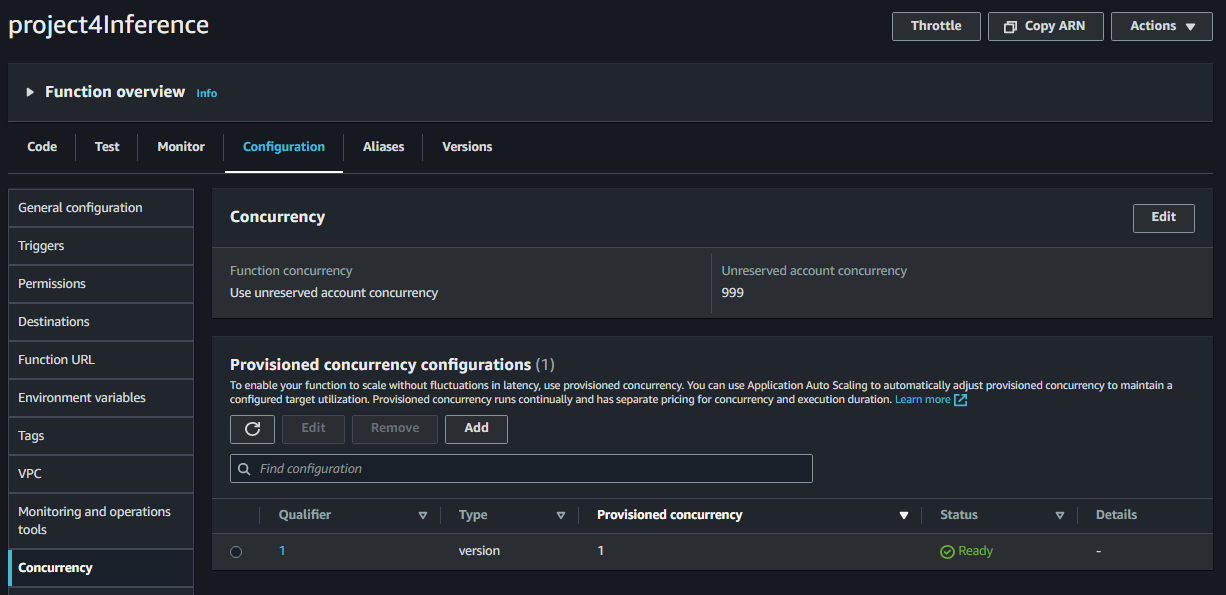In this project, several important tools and features of AWS are used to adjust, improve, configure, and prepare a ML model for production deployment. The project contains code that trains and deploys an image classification model on AWS Sagemaker.
The project is performed following the next steps:
Step 1: Training and deployment on AWS Sagemaker.
Step 2: Training using EC2.
Step 3: Lambda function setup for inference.
Step 4: Lambda security setup and testing.
Step 5: Lambda concurrency setup and endpoint auto-scaling.
The training process is performed using a Notebook instance on Sagemaker. A small instance type such as ml.t3.medium (2 vCPU and 6 GiB of memory) is selected for the project, since this meets the requirements for running the train_and_deploy-solution.ipynb notebook at the lowest cost of $ 0.05 per hour.
The following image shows the notebook instance created:
A S3 bucket is set up in order to storage the training data:
The model is trained on both single and multiple instances using a ml.g4dn.xlarge instance type. For practical purposes, the training halts at the first epoch. Then, the models from single instance and multiple instance training jobs are deployed, as follows:
- Single-instance training:
- Multi-instance training:
An alternative for training a model is using an EC2 instance instead of Sagemaker. In this scenario, a script adapted from the notebook is necessary. The instance type chosen for training the model on EC2 is the same ml.g4dn.xlarge, since it meets the computing requeriments at a lower cost for processing and training. As said before, for practical purposes, the training will halt at the first epoch.
The following images shows the EC2 instance and the terminal running the ec2train1.py script for training the model.
After training and deploying the model, setting up a Lambda function, using the lamdafunction.py script, is an important task as this enables the model to be accessed by API's and other programs.
Once the Lambda function is configured, it will return an error when performing a request test to invoke the Sagemaker deployed endpoint. This error is returned since the Lambda function role has no permissions to access the endpoint.
When choosing a proper policy to resolve the security issue, it is necessary to evaluate some vulnerabilities such as the following:
- Setting up a “FullAccess” policy without restrictions is a vulnerability that can be exploited by external elements, such as cybercriminals, in case of an unauthorized access to the Lambda Function.
- Roles that are old or inactive pose a security risk that can compromise a Lambda Function, hence they should be identified and removed.
- Roles with policies for Lambda functions that are no longer in use are also a potential risk of unauthorized access and they should be revoked and deleted.
For this project, a suitable policy that limits access to invoke a specific Sagemaker endpoint is created and attached to the Lambda role using the IAM interface, as follows:
The results of a successful invoking test performed on the Lambda function are shown below:
{
"statusCode": 200,
"headers": {
"Content-Type": "text/plain",
"Access-Control-Allow-Origin": "*"
},
"type-result": "<class 'str'>",
"COntent-Type-In": "<__main__.LambdaContext object at 0x7f7a3ec646a0>",
"body": "[[0.3748210370540619, -0.046208158135414124, -0.19332340359687805, 0.18459755182266235, 0.6422909498214722, 0.35926416516304016, 0.07143840193748474, 0.2013409584760666, -0.40662631392478943, -0.2238309532403946, 0.1126127690076828, 0.2525499165058136, 0.09177562594413757, 0.09780372679233551, 0.5082946419715881, 0.2655788064002991, 0.3439544439315796, -0.4079475402832031, -0.18330448865890503, 0.4885449707508087, 0.2703157365322113, 0.15254491567611694, 0.4578859508037567, 0.4886816740036011, -0.2267102301120758, 0.06121187284588814, 0.08620661497116089, -0.07932054996490479, 0.49667492508888245, 0.3141535520553589, 0.07674485445022583, 0.1663159877061844, -0.25284793972969055, 0.21378761529922485, 0.25132060050964355, 0.5610526204109192, 0.18995662033557892, 0.13628947734832764, 0.1684465855360031, -0.15521439909934998, 0.4581757187843323, 0.1620015799999237, 0.30257973074913025, 0.09637795388698578, 0.04541651904582977, 0.1521347463130951, -0.08743750303983688, 0.04993806779384613, -0.20915032923221588, -0.21284787356853485, -0.02543587237596512, 0.1883545070886612, -0.30492720007896423, 0.18603497743606567, -0.2546696066856384, 0.1975076049566269, 0.4556020200252533, 0.16756783425807953, 0.12390435487031937, -0.1146358922123909, 0.11059819906949997, -0.11682835221290588, 0.0710432380437851, -0.4874916970729828, 0.05493775010108948, -0.4273858070373535, -0.10279837250709534, 0.12126364558935165, 0.29550567269325256, 0.18309897184371948, 0.06595314294099808, -0.025738196447491646, -0.30459538102149963, 0.01492330338805914, -0.15622296929359436, 0.18880636990070343, -0.2251722812652588, -0.2873472273349762, 0.1890975534915924, -0.003290688619017601, -0.10139472037553787, 0.29221588373184204, 0.055993661284446716, 0.1098623126745224, -0.1766642928123474, 0.08243223279714584, 0.3377177119255066, 0.06499467045068741, 0.24551309645175934, 0.3099081516265869, -0.04492253065109253, -0.2474137842655182, -0.5685271620750427, -0.3114491403102875, -0.39963656663894653, -0.33272674679756165, -0.08196931332349777, -0.1892833411693573, -0.09226399660110474, -0.4018873870372772, -0.06535250693559647, -0.4086303412914276, -0.07361125200986862, -0.02084951475262642, -0.508001446723938, -0.1040288507938385, -0.4590185582637787, -0.9188807606697083, -0.010974306613206863, -0.4687262773513794, -0.05386451259255409, 0.1874505877494812, -0.014306633733212948, -0.3130384385585785, 0.3803076446056366, -0.5665944814682007, -0.14233903586864471, -0.19892369210720062, -0.6708981990814209, -0.24014577269554138, -0.7050748467445374, -0.48393329977989197, -0.051612406969070435, -0.26194262504577637, -0.480593204498291, -0.6064732670783997, 0.01859777607023716, -0.3616325557231903, 0.152866393327713, 0.26529568433761597, -0.5362987518310547, -0.5450462102890015, -0.34911587834358215]]"
}In order to prepare a Lambda function to respond to high traffic demand with low latency, i.e multiple invocations at once, provisioned concurrency can be set up. The price depends on the amount of memory is allocated to the function and the amount of concurrency. For the purposes of this project, a small amout of concurrency is set up, as follows:
Finally, like Lambda functions use concurrency to respond to multiple requests at the same time, Sagemaker endpoints require automatic scaling to perform in a similar scenario. For this project, the auto-scaling setup with a maximun of 2 instances is shown in the following image:












